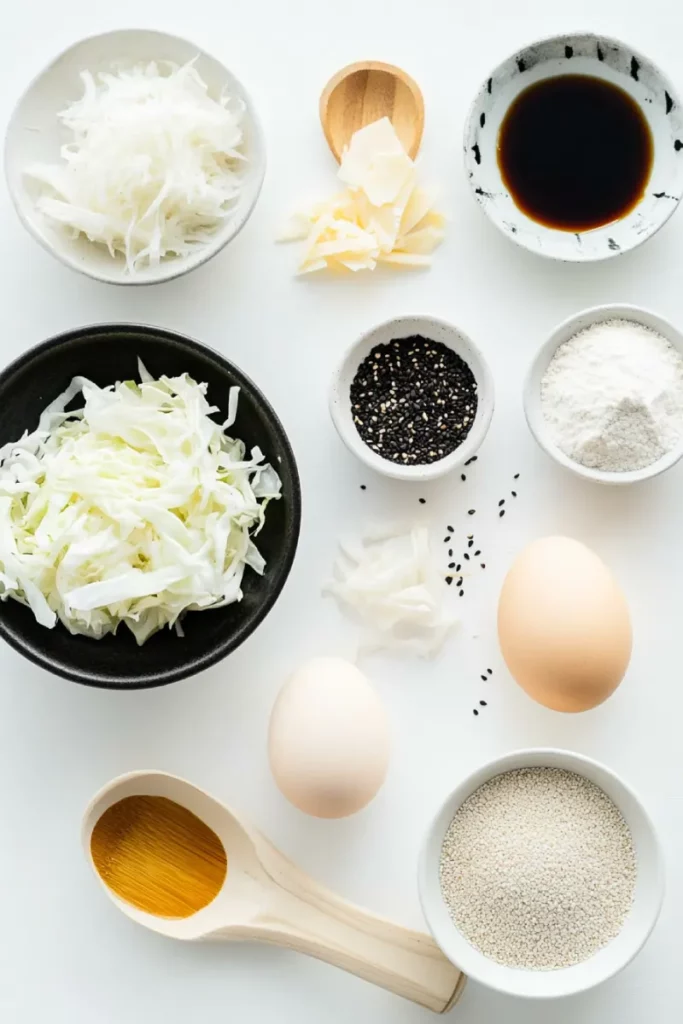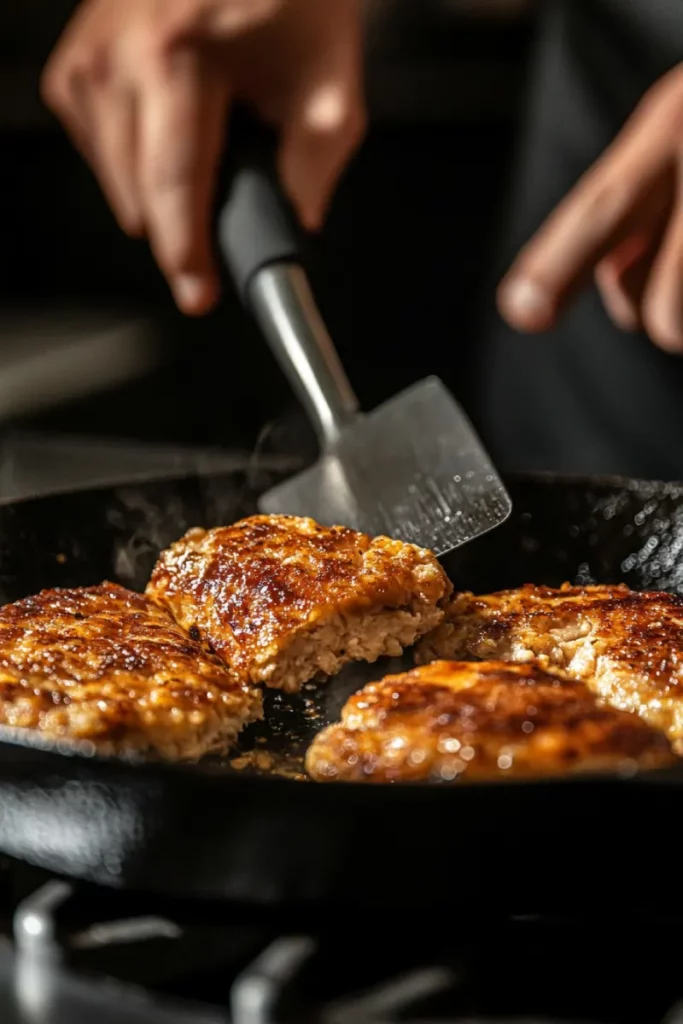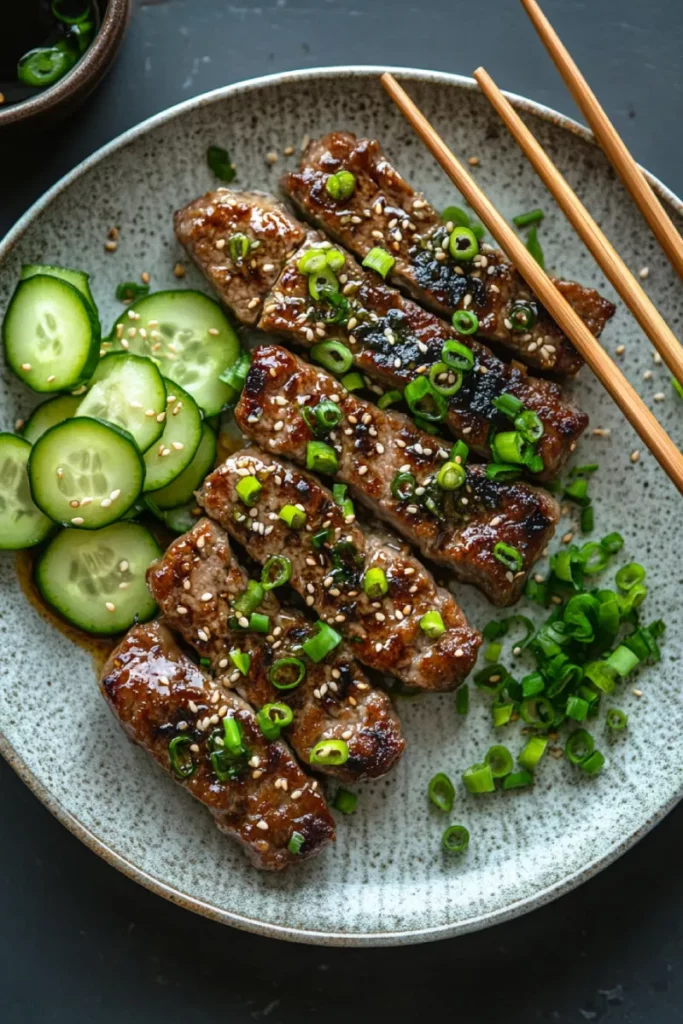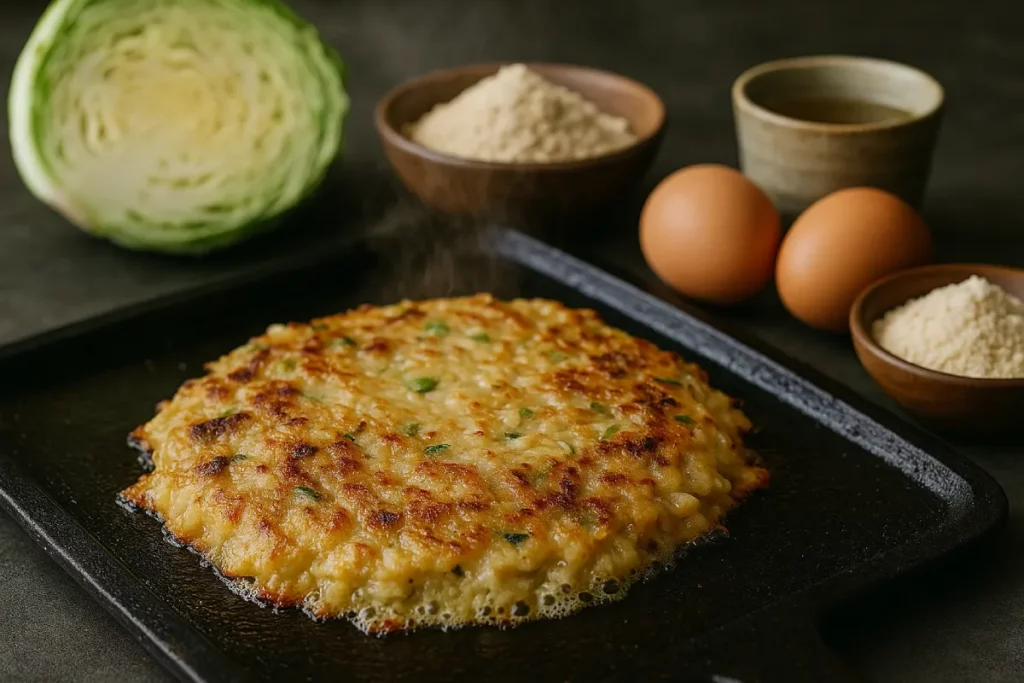Craving Japanese street food but watching your carbs? Low-carb monjayaki might be your perfect answer. Monjayaki is a savory pan-fried dish, similar to okonomiyaki, but with a gooier texture and endless topping possibilities. Traditionally made with flour and carb-heavy ingredients, monjayaki isn’t low-carb by default — but with the right swaps, you can enjoy every bite without breaking your goals. This article will show you how to make a flavorful low-carb monjayaki that satisfies cravings, fits a keto or diabetic lifestyle, and tastes just as authentic as the original.
We’ll walk through health-friendly ingredients, step-by-step cooking instructions, prep tips, carb counts, and even creative variations to keep things fresh. You’ll also discover how to pair your low-carb monjayaki with other healthy dishes like our Thai Salmon or Garlic Parmesan Cheeseburger Bombs for a full meal.
PART 1: What Is Low-Carb Monjayaki and Why It’s Trending
The origin of monjayaki and its modern low-carb twist
Monjayaki is a classic dish from Tokyo’s Tsukishima district, known for its soft texture and customizable ingredients. Traditionally made with wheat flour and savory dashi broth, it’s often grilled directly on a teppan (flat iron plate) and scooped straight off with tiny spatulas.
However, standard monjayaki can be high in carbs due to the flour base. That’s where low-carb monjayaki comes in. By replacing flour with low-carb options like coconut flour, almond flour, or psyllium husk, you get the same gooey comfort — minus the carb load. Even the sauce and toppings can be easily adjusted for keto, diabetic, or low-carb eating styles.
Why low-carb monjayaki fits modern diets
The surge in low-carb eating, especially among keto followers and those managing diabetes, has brought renewed attention to low-carb monjayaki. This dish fits perfectly into a macro-conscious meal plan. It’s high in protein, low in net carbs, and rich in healthy fats when prepared with ingredients like eggs, cabbage, cheese, and lean meats.
Because of its flexible nature, low-carb monjayaki works for lunch, dinner, or even as a party appetizer. You can prep it quickly and cook it on a skillet or electric grill. Want more low-carb Japanese ideas? Try our Japanese Mounjaro Recipe which shares similar savory, health-focused flavors.
PART 2: Best Low-Carb Ingredients for Monjayaki
Top low-carb swaps for monjayaki batter
Creating the perfect low-carb monjayaki starts with replacing the traditional wheat flour base. The good news? You can easily replicate the texture and flavor with healthier, low-carb alternatives that keep your dish keto-friendly and gluten-free.
Here are the top low-carb swaps:
- Coconut flour – Light, absorbent, and just 2g net carbs per tablespoon. It gives your low-carb monjayaki structure without heaviness.
- Almond flour – Great for added fat and fiber, plus a subtle nutty flavor that pairs well with savory fillings.
- Psyllium husk – Ideal for giving your batter a gooey texture that mimics traditional monjayaki. It also adds digestive benefits.
- Eggs – They help bind everything together and increase the protein profile of your low-carb monjayaki.
Pair these with a low-sodium dashi broth or even a keto-friendly vegetable broth for the perfect batter consistency. For a creamy finish, some people add a tablespoon of mayonnaise or shredded cheese.
Looking for more low-carb base recipes? Our Tortilla Quiche Bake uses similar ingredient swaps and makes a great breakfast pairing.
Best proteins and vegetables for low-carb monjayaki
One of the best things about low-carb monjayaki is how customizable it is. You can toss in whatever you love, as long as it fits your macros. Below are smart choices that keep your carbs low and your flavor high:
- Cabbage – Essential for crunch and bulk, with only 2g net carbs per cup.
- Zucchini – Grated, it blends smoothly into the batter and absorbs flavor well.
- Ground chicken or pork – Adds savory depth without excess fat.
- Shrimp or scallops – For a seafood twist that’s light and rich in protein.
- Cheese – Melts beautifully into the batter, giving that oozy monjayaki finish.
Avoid starchy add-ins like corn, sweet sauces, or traditional yakisoba. Stick with clean, low-carb options that boost nutrition.
Need flavor inspiration? Check out our Seared Scallops with Spicy Cajun Cream Sauce — many of its ingredients double as monjayaki fillings.
PART 3: How to Make Low-Carb Monjayaki at Home
Simple low-carb monjayaki recipe (keto-friendly)
If you’re ready to try this flavorful dish, this low-carb monjayaki recipe is easy, fast, and packed with flavor. It’s ideal for keto, diabetic, or gluten-free diets and only takes about 15 minutes from start to finish.
Ingredients:
- 1/4 cup cabbage, finely chopped
- 2 tbsp coconut flour
- 1 tbsp almond flour
- 1 tsp psyllium husk (optional for gooey texture)
- 2 eggs
- 2 tbsp shredded mozzarella or cheddar
- 1/4 cup cooked ground chicken or pork
- 1/4 tsp garlic powder
- 1 tbsp low-carb soy sauce or coconut aminos
- 1/3 cup dashi broth or veggie broth
- 1 tbsp avocado oil (for cooking)

Instructions:
- In a mixing bowl, combine cabbage, coconut flour, almond flour, psyllium husk, and eggs. Mix until well blended.
- Add cheese, cooked meat, garlic powder, soy sauce, and broth. Stir until a loose batter forms.
- Heat a skillet or nonstick pan with avocado oil over medium heat.
- Pour the batter into the skillet and press gently with a spatula to spread it evenly.
- Let it cook for 3–4 minutes until the bottom is lightly browned and the mixture starts to firm.
- Flip or fold the edges inward and cook another 2–3 minutes until gooey but cooked through.
- Serve hot with optional keto mayo, sesame seeds, or green onions on top.

This version of low-carb monjayaki gives you all the savory, chewy satisfaction of the original — minus the carb crash. It’s perfect for dinner or as a late-night snack.
Make-ahead tips and storage
To make your low-carb monjayaki routine even easier, try prepping the batter ahead of time. Store it in an airtight container in the fridge for up to 24 hours. The texture may thicken slightly, but you can thin it with a splash of broth.
Cooked monjayaki can be refrigerated for 2–3 days and reheated in a skillet or air fryer. It won’t get crispy, but it will retain its savory flavor and gooey texture.
Want a different low-carb comfort food? Our Cream Sauce Base HelloFresh Recipe is another creamy, low-carb option perfect for weeknights.
PART 4: Topping and Filling Ideas for Low-Carb Monjayaki
Creative low-carb fillings that boost flavor
One of the biggest benefits of making low-carb monjayaki is how easy it is to customize. You can rotate fillings based on your mood, macros, or what’s in your fridge — all while keeping carbs low and flavor high.
Here are tasty, keto-friendly fillings to try in your next low-carb monjayaki:
- Kimchi (unsweetened) – Adds spice and probiotics with just 1–2g net carbs per serving
- Crumbled bacon – Smoky, crispy, and perfect for texture
- Shredded rotisserie chicken – A fast protein boost without extra prep
- Canned tuna – Affordable, lean, and delicious with melted cheese
- Sautéed mushrooms – Earthy and low-carb, they soak up flavor beautifully
- Spinach or kale – Light greens that wilt into the batter for added fiber
Each of these ingredients keeps your low-carb monjayaki versatile and nutrient-rich. If you’re already eating keto or low-carb, most of these items are pantry staples.
Looking for a similar high-protein dish? Try our Chicken Parm Cottage Cheese Bowl — low-carb and loaded with flavor.
Low-carb toppings to finish it right
Once your low-carb monjayaki is cooked, it’s time to dress it up. Classic toppings like okonomiyaki sauce are off-limits due to sugar, but there are plenty of low-carb ways to finish your dish:
- Sugar-free sriracha or chili garlic sauce – Adds heat without carbs
- Japanese kewpie mayo (low-carb version) – Rich, tangy, and keto-approved
- Toasted sesame seeds – Nutty crunch without the carbs
- Green onions – Bright flavor, minimal carbs
- Nori flakes or shredded seaweed – Adds umami and depth
- Low-carb teriyaki drizzle – Made with tamari, garlic, and erythritol
These toppings elevate your low-carb monjayaki without adding sugar or starch. Keep your servings light and flavorful by avoiding sauces with corn syrup or wheat.
Bonus idea: Try your monjayaki alongside our Blue Salt Trick for Men — it’s a savory side that complements Japanese flavors well.
PART 5: Nutrition Breakdown of Low-Carb Monjayaki
How many carbs are in low-carb monjayaki?
One of the biggest reasons people choose low-carb monjayaki is its ability to satisfy while staying within strict carb limits. By using low-carb flours and clean ingredients, each serving can come in well under 10g net carbs — a perfect fit for keto or low-glycemic plans.
Here’s a basic nutrition estimate per one medium-sized serving of low-carb monjayaki:| Nutrient | Amount |
|---|---|
| Net Carbs | 6–8g |
| Protein | 18–22g |
| Fat | 12–16g |
| Calories | 240–280 |
This makes low-carb monjayaki a balanced, satiating meal that won’t spike your blood sugar — perfect for people on keto, diabetic-friendly diets, or low-carb weight loss plans.
Want another high-protein, low-carb dish? Don’t miss our Easy Baked Ranch Chicken for an oven-ready meal with minimal carbs.
What makes this low-carb monjayaki different nutritionally?
What sets low-carb monjayaki apart from the traditional version is the shift from refined carbs to fiber-rich and protein-rich ingredients. Instead of flour and starch, you’re getting:
- Healthy fats from eggs, cheese, and avocado oil
- More fiber from coconut flour and vegetables
- Higher protein from meat, seafood, and eggs
- Fewer blood sugar spikes — thanks to lower glycemic ingredients
This nutritional profile makes low-carb monjayaki ideal for long-term energy, better digestion, and fewer cravings — all while enjoying a dish that feels indulgent.
For other gut-friendly low-carb meals, check out our Natural Mounjaro Recipe Tea which also helps with digestion and fat-burning.
PART 6: Perfect Pairings for Low-Carb Monjayaki Meals
Low-carb sides that match well with monjayaki
While low-carb monjayaki is filling on its own, pairing it with complementary low-carb sides turns it into a full, satisfying meal. You want to keep the meal flavorful but balanced — avoiding anything that adds unnecessary carbs or sugars.
Here are great low-carb sides to serve with your monjayaki:
- Japanese cucumber salad – Crisp, refreshing, and only 2g net carbs per serving
- Miso soup (low-carb version) – Made with shirataki noodles and tofu instead of miso paste with rice
- Roasted seaweed sheets (nori) – Crunchy and salty, a fun way to scoop up bites of your low-carb monjayaki
- Grilled eggplant slices – Simple, tender, and pairs beautifully with savory Japanese flavors
- Steamed edamame (in moderation) – High in protein and fiber, with just enough carbs to round out the meal
Each option keeps the focus on flavor without exceeding carb limits. These sides help balance the texture of low-carb monjayaki, making the meal feel more authentic and restaurant-style.
Want another light, flavorful side dish? Try this zesty Pineapple Teriyaki Chicken — just skip the sauce or use a low-carb version.

Low-carb drinks to pair with your meal
A great drink makes your meal feel complete. Instead of sugary sodas or carb-heavy cocktails, go with beverages that support digestion and hydration — perfect for balancing the richness of low-carb monjayaki.
Smart low-carb drink options:
- Green tea – Hot or cold, it aids digestion and enhances Japanese flavors
- Sparkling water with lemon or cucumber slices – Clean, crisp, and zero carb
- Matcha tea – A metabolism booster that pairs perfectly with savory Japanese dishes
- Keto electrolyte drinks – If you’re on strict keto, these help replenish minerals after a salty meal
- Cold brew oolong tea – Rich and earthy, with a natural fat-burning kick
These drinks complement your low-carb monjayaki without adding sugar, carbs, or artificial flavors.
Need a detox drink to pair with your meal? Check out our Natural Matcha Detox Drink for Weight Loss — it’s clean, effective, and tastes amazing with Japanese food.
PART 7: Common Mistakes to Avoid When Making Low-Carb Monjayaki
Why your low-carb monjayaki might not taste right
Even with the best ingredients, your low-carb monjayaki can fall short if you’re making key mistakes. Many home cooks try this recipe and feel disappointed by the texture or flavor. But it’s not the concept — it’s often the method.
Here are the most common problems:
- Too much coconut flour
Coconut flour is very absorbent. Adding more than needed can make your low-carb monjayaki dry and crumbly instead of gooey and soft. - Overcooking the batter
Monjayaki should be cooked until just firm. Overcooking makes it rubbery. Aim for a slightly runny center that firms up as it cools. - Using the wrong pan
Nonstick or cast iron is ideal. If your pan sticks, your low-carb monjayaki won’t spread or flip properly. Use a well-oiled surface and medium heat. - Skipping seasoning
Low-carb flours are neutral. Always season the batter with garlic powder, soy sauce, or spices — or the dish will fall flat.
Want a properly textured recipe with foolproof seasoning? Check out our Brazilian Mounjaro Recipe 3 Ingredients — simple, flavorful, and low-carb-friendly.
Mistakes that ruin low-carb benefits
It’s also easy to unknowingly turn your low-carb monjayaki into a high-carb meal. Here’s how:
- Adding sugary sauces
Bottled okonomiyaki sauces are loaded with sugar. Use low-carb substitutes or skip them altogether. - Using imitation crab or sweetened proteins
Imitation crab often contains starch. Stick with whole meats like chicken, tuna, or shrimp. - Too many starchy vegetables
Skip corn, carrots, or peas — all common in traditional monjayaki but not keto-compatible. - Overloading cheese
While cheese is low-carb, adding too much can throw off the balance of your dish and lead to excess calories or sodium.
Stick to the ingredient list and portion sizes from our Low-Carb Monjayaki Recipe to get the right flavor and nutritional balance every time.
PART 8: Is Low-Carb Monjayaki Keto? How It Compares to Other Japanese Dishes
Can low-carb monjayaki fit a strict keto lifestyle?
Yes — when made with the right ingredients, low-carb monjayaki is absolutely keto-compliant. A traditional monjayaki uses wheat flour and sugary sauces, which spike carbs quickly. But with almond flour, coconut flour, psyllium husk, and carb-conscious toppings, you can enjoy monjayaki with fewer than 8g net carbs per serving.
The base of your low-carb monjayaki is where the keto success lies. Swapping high-carb ingredients for healthy fats and protein ensures it fits within a standard keto macro ratio: 70% fat, 25% protein, 5% carbs. Just be sure to avoid hidden carbs in sauces or toppings.
For another proven low-carb/keto dish, our Low-Carb Mounjaro Recipes offer a wide variety of tasty, satisfying options you can rotate weekly.
How low-carb monjayaki compares to other Japanese dishes
Many Japanese favorites are loaded with rice, noodles, or starch-heavy sauces. Compared to these, low-carb monjayaki is one of the few authentic-tasting options that works on keto.
Here’s how it stacks up:| Dish | Approx. Net Carbs | Keto-Friendly? |
|---|---|---|
| Sushi (with rice) | 35–50g per roll | No |
| Ramen (with noodles) | 40–60g per bowl | No |
| Okonomiyaki | 25–35g | No |
| Low-Carb Monjayaki | 6–8g | Yes |
As you can see, low-carb monjayaki is one of the few traditional-style Japanese comfort foods that fits your carb goals. It gives you all the savory richness without the carb overload.
Frequently Asked Questions About Low-Carb Monjayaki
What is low-carb monjayaki made of?
Low-carb monjayaki is made using coconut flour, almond flour, eggs, cabbage, and keto-friendly proteins like ground chicken, shrimp, or tuna. Unlike traditional monjayaki, which uses wheat flour and starchy sauces, low-carb monjayaki keeps net carbs under 10g per serving by focusing on clean, low-glycemic ingredients.
Is low-carb monjayaki keto-friendly?
Yes, low-carb monjayaki is completely keto-friendly when made with the right ingredients. It contains high fat, moderate protein, and low carbs — perfect for a standard keto macro split. Just be sure to avoid sugary sauces and use low-carb flavor options like soy sauce, sesame oil, or keto mayo.
How does low-carb monjayaki taste compared to the original?
While the texture is slightly less gooey than the flour-based version, the flavor of low-carb monjayaki remains rich, savory, and customizable. You can add bacon, cheese, kimchi, seafood, or garlic to give it a strong umami flavor that rivals or even beats traditional versions.
Can I freeze low-carb monjayaki batter?
It’s best to prepare your low-carb monjayaki fresh, but you can store the batter in an airtight container in the fridge for 24 hours. Freezing is not recommended, as it may affect the consistency due to coconut flour and psyllium husk absorbing moisture unevenly.
What sauces can I use on low-carb monjayaki?
Stick to low-carb sauces like sugar-free sriracha, coconut aminos, or homemade keto okonomiyaki sauce using tamari, garlic, and a keto sweetener. Traditional sauces contain sugar and starch, which should be avoided to keep your low-carb monjayaki keto-approved.
Can I eat low-carb monjayaki on a diabetic diet?
Absolutely. Since low-carb monjayaki is low in carbohydrates and made with blood sugar-stabilizing ingredients like eggs, leafy greens, and fiber-rich flour alternatives, it’s a smart option for those managing blood glucose.
Conclusion
If you’ve been missing Japanese comfort food on your low-carb or keto diet, low-carb monjayaki brings it back — with none of the guilt. This gooey, savory dish transforms high-carb street food into a macro-friendly, blood sugar-safe meal you can enjoy anytime. With just a few smart swaps like coconut flour, almond flour, lean proteins, and low-carb toppings, your monjayaki becomes not only healthier, but just as satisfying as the traditional version.
Whether you’re eating low-carb for weight loss, managing diabetes, or following a strict ketogenic plan, low-carb monjayaki fits seamlessly into your routine. It’s fast, flexible, and endlessly customizable. You can enjoy it with simple sides, light sauces, and clean drinks — all while staying on track with your goals.
Ready to start? Gather your ingredients and try your first homemade low-carb monjayaki today. Once you taste it, you’ll wonder why you ever thought you had to give up Japanese food at all.
For more tips, recipes, and daily updates, follow us on Pinterest and Facebook — just search ‘Tasty With Us’ to stay connected!
Printable Recipe Card
Want just the essential recipe details without scrolling through the article? Get our printable recipe card with just the ingredients and instructions.



